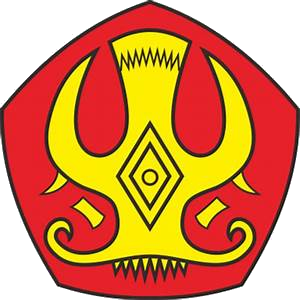Kuat Lentur Balok Laminasi Kombinasi Kayu Jawa (Lannea Coromandelica) dan Gelugu (Cocos nucifera)
DOI:
https://doi.org/10.22487/renstra.v5i2.670Keywords:
mixed glue laminated beams, Lannea coromandelica, Cocos nucifera, flexural strength of woodAbstract
The use of kayu Jawa (Lannea coromandelica) and gelugu (Cocos nucifera) is very necessary to reduce the forests exploitation as a source of wood raw materials. However, both have debility in terms of mechanical properties and maximum dimensional achievement. Therefore, a mixed glulam system can be applied to produce lightweight structural timber beams with adequate performance. This research is aimed at determining the flexural strength, stiffness, ductility and failure of mixed glulam beams combined with kayu Jawa and Gelugu. A series of bending tests were carried out on timber beams using the three point bending method on three categories of beams, namely B-J, B-G and B-L. B-J beams, consist of solid timber of kayu jawa which has density ± 0,60 gr/cm3, B-K consist of solid gelugu which has density ± 0.88 gr/cm3, while B-L consists of kayu jawa timber in the core zone and one layer of 10 mm thick gelugu with a density of 0,88 gr/cm3 on the tension zone. Each beams category consists of five replications with the dimensions of each beam being 50 mm of wide, 55 mm of high and 760 mm of span. Laminated beams (B-L) are glued with emulsion adhesive with Viscosity 2,500 – 4,500 cPS, resin content 90 – 91%, gel time: 1 hour and curing time 5 – 6 hours with two-sided coating of 250 gr/m2 and clamping force 2 MPa. The results of this research show that the flexural strength (fb) and stiffness (EI) of mixed glue laminated laminated beams are 1,3 times higher than B-J. Apart from that, mixed glue laminated laminated beams (B-L) there was an increase the ductility of 47% when compared to B-G.
Downloads
References
C. Siagian, S.O. Dapas, and R.E. Pandaleke, “Pengujian Kuat Lentur Kayu Profil Tersusun Bentuk Kotak”, Jurnal Sipil Statik , vol. 5, no. 2, p. 95, 2017.
M.N. Matana, E.J. Kumaat, and R.E. Pandaleke, “Pengujian Kuat Lentur Kayu Profil Tersusun Bentuk I”, Jurnal Sipil Statik , vol. 5, no. 2, p. 103, 2017.
Pujianto, A. Basuki, and B. Utomo, “Uji Kuat Lentur Kayu dengan Tambalan Serbuk Gergaji, Serbuk Ketam dan Serbuk Amplasan Kayu”, Matriks Teknik Sipil, vol. 1, no. 1, p. 1, 2013.
J.M. Khatib, Sustainability of Construction Materials, Washington: Woodhead Publishing Limited, 2009.
M. Calkins. Materials for Sustainable Sites, A Complete Guide to The Evaluation, Selection, and Use of Sustainable Construction Materials, New Jersey: John Wiley & Sons, 2009.
S. Thelandersson and H.J. Larsen, Timber Engineering, Singapore: John Wiley & Sons, 2003.
A. Awaludin and U. Wusqo, “Prediksi Nilai Kuat Lentur Kayu Tropis Berdasarkan Nilai Modulus Elastis”, Jurnal Ilmu dan Teknologi Kayu Tropis, vol. 18, no .1, p. 27, 2020.
BPS, Statistik Indonesia 2010: Statistical Yearbook of Indonesia 2010, Jakarta: Badan Pusat Statistik. 2010.
R.N. Arancon, Asia Pacific Forestry Sector Outlook: Focus on Coconut Wood. 23 No. APFSOS/WP/23 ASIA. Bangkok: WFA, 1997.
L. Fathi, Structural and Mechanical Properties of the Wood from Coconut Palms, Oil Palms and Date Palms, Hamburg: Fakultät Für Mathematik, Informatik und Naturwissenschaften, Universität Hamburg, 2014.
Forest Products Laboratory, Wood Handbook Wood as An Engineering Material, New York: Department of Agriculture, 2010.
E. Serrano and H.J. Larsen, “Numerical Investigations of the Laminating Effect in Laminated Beams”, Journal of Structural Engineering, vol. 125, no. 7, p. 740, 1999.
R.H. Falk and F. Colling, “Laminating Effects in Glued-Laminated Timber Beams”, Journal of Structural Engineering, vol. 121, no. 12, p. 1857, 1995.
ASTM, D143-14: Standard Test Methods for Small Clear Specimens of Timber, USA: ASTM International, 2014.
ASTM, D.198-02: Standard Test Methods of Structural Size of Lumber, USA: ASTM International, 2000.
J.M. Gere, Mechanics of Materials, USA: Thomson Learning, 2004.
Downloads
Published
How to Cite
Issue
Section
License
Copyright (c) 2024 REKONSTRUKSI TADULAKO: Civil Engineering Journal on Research and Development

This work is licensed under a Creative Commons Attribution 4.0 International License.







 This work is licensed under a
This work is licensed under a 


